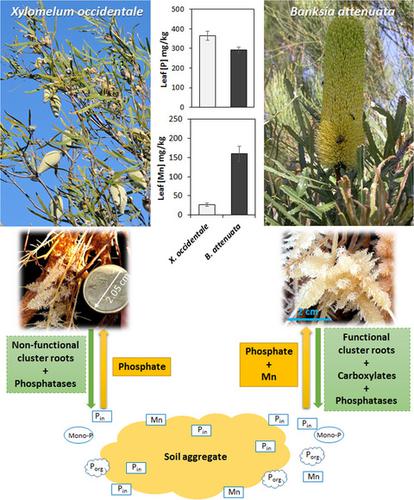Our official English website, www.x-mol.net, welcomes your feedback! (Note: you will need to create a separate account there.)
Xylomelum occidentale (Proteaceae) accesses relatively mobile soil organic phosphorus without releasing carboxylates
Journal of Ecology ( IF 5.5 ) Pub Date : 2020-07-11 , DOI: 10.1111/1365-2745.13468 Hongtao Zhong 1 , Jun Zhou 1, 2 , Azrul Azmi 1 , André J. Arruda 1, 3 , Ashlea L. Doolette 4 , Ronald J. Smernik 4 , Hans Lambers 1
中文翻译:

西方木乃伊(Proteaceae)获取相对流动的土壤有机磷而不会释放羧酸盐
更新日期:2020-07-11
Journal of Ecology ( IF 5.5 ) Pub Date : 2020-07-11 , DOI: 10.1111/1365-2745.13468 Hongtao Zhong 1 , Jun Zhou 1, 2 , Azrul Azmi 1 , André J. Arruda 1, 3 , Ashlea L. Doolette 4 , Ronald J. Smernik 4 , Hans Lambers 1
Affiliation

|
- Hundreds of Proteaceae species in Australia and South Africa typically grow on phosphorus (P)‐impoverished soils, exhibiting a carboxylate‐releasing P‐mobilizing strategy. In the Southwest Australian Biodiversity Hotspot, two Xylomelum (Proteaceae) species are widely distributed, but restricted within that distribution.
- We grew Xylomelum occidentale in hydroponics at 1 μM P. Leaves, seeds, rhizosheath and bulk soil were collected in natural habitats.
- Xylomelum occidentale did not produce functional cluster roots and occupied soils that are somewhat less P‐impoverished than those in typical Proteaceae habitats in the region. Based on measurements of foliar manganese concentrations (a proxy for rhizosphere carboxylate concentrations) and P fractions in bulk and rhizosheath soil, we conclude that X. occidentale accesses organic P, without releasing carboxylates. Solution 31P‐NMR spectroscopy revealed which organic P forms X. occidentale accessed.
- Xylomelum occidentale uses a strategy that differs fundamentally from that typical in Proteaceae, accessing soil organic P without carboxylates. We surmise that this novel strategy is likely expressed also in co‐occurring non‐Proteaceae that lack a carboxylate‐exuding strategy. These co‐occurring species are unlikely to benefit from mycorrhizal associations, because plant‐available soil P concentrations are too low.
- Synthesis. Our findings show the first field evidence of effectively utilizing soil organic P by X. occidentale without carboxylate exudation and explain their relatively restricted distribution in an old P‐impoverished landscape, contributing to a better understanding of how diverse P‐acquisition strategies coexist in a megadiverse ecosystem.
中文翻译:

西方木乃伊(Proteaceae)获取相对流动的土壤有机磷而不会释放羧酸盐
- 在澳大利亚和南非,数以百计的Proteaceae物种通常生长在磷(P)贫瘠的土壤上,表现出释放羧酸盐的P迁移策略。在澳大利亚西南部生物多样性热点地区,两个木犀科(Proteaceae)分布较广,但仅限于该分布内。
- 我们以1μMP在水培法中培养了Xylomelum occidentale。在自然栖息地中收集了叶子,种子,根茎和大量土壤。
- Xylomelum occidentale没有产生功能性的簇根和被占领的土壤,其贫困程度比该地区典型的Proteaceae栖息地少。根据大量和根际土壤中叶面锰浓度(根际羧酸盐浓度的代表)和P分数的测量结果,我们得出结论,西方石油X.ocidentale获取有机P,而不会释放羧酸盐。溶液31的P-NMR光谱揭示了进入X. occidentale的有机P形式。
- Xylomelum occidentale所采用的策略与Proteaceae中的典型策略完全不同,可获取不含羧酸盐的土壤有机P。我们推测,这种新颖的策略也可能在缺少羧酸盐渗出策略的非Proteaceae同时出现。这些共同存在的物种不太可能受益于菌根协会,因为植物可利用的土壤P浓度太低。
- 综合。我们的发现表明,第一个现场证据有效地利用了X. occidentale的土壤有机磷而没有羧酸盐的渗出,并解释了它们在较老的P贫困地区相对有限的分布,有助于更好地了解各种P收购策略在大型生物中如何共存。生态系统。



























 京公网安备 11010802027423号
京公网安备 11010802027423号